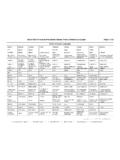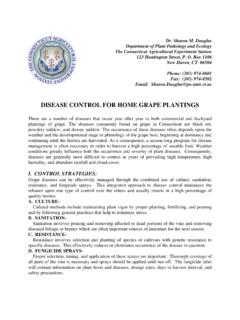Transcription of THE PATHOPHYSIOLOGY OF ALZHEIMER’S DISEASE AND …
1 256 Vol. 3, No. 8nOctober 2005 ABSTRACTThe PATHOPHYSIOLOGY of alzheimer s DISEASE (AD) is complex, involving several neurotransmit-ter systems and pathophysiologic processes. The 3hallmarks of AD -amyloid plaques, neurofibril-lary tangles, and neuronal cell death are wellknown and central factors in AD pathology. Thesehallmarks, combined with our information on neu-rotransmitter involvement, are specific to ADbased on the timing, sequence, and location ofthese changes. This article reviews the pathophys-iology and course of brain damage seen duringAD progression, from preclinical to severe these processes is fundamental inunderstanding AD progression and symptommanifestation, and in assessing the potential risksand benefits of therapeutic interventions.
2 Thereare now 5 approved drugs for the cognitive symp-toms of AD 4 acetylcholinesterase inhibitors(approved for mild to moderate AD) and 1 non-competitive glutamate receptor antagonist(approved for moderate to severe AD). Recentstudies with these drugs are focusing on longer-term follow-up (1 year and beyond), in addition tomore clinically relevant outcomes, such as measures of function and nursing home placement. Other treatments (vitamins E and/orC, nonsteroidal anti-inflammatory drugs, andstatins [cholesterol-lowering drugs]) show somepromise in preventing or delaying AD progres-sion, although more data are needed.
3 There arenow several published guidelines for the treat-ment of AD. Although some may argue that theeffect of these drugs is modest, any preservationof function and delay of nursing home placementhas important and permanent consequences forthe patient and caregiver. The profound andsometimes rapid loss of memory and functionwith AD underscores the importance of trying atleast 1 of these treatments in a patient with AD.(Adv Stud ;3(8):256-270) alzheimer SDISEASEPATHOPHYSIOLOGYCHANGESINBRAINSTR UCTUREA lzheimer s DISEASE (AD) pathology can be charac-terized on a macro level as the progressive loss of braintissue.
4 As the DISEASE progresses, neurons die in a par-ticular pattern over time. One of the earliest signs ofAD is memory loss, particularly short-term recall. Thebrain areas involved in memory include the cortex,especially the hippocampus (Figure 1).1 Preclinical ADbegins in the entorhinal cortex, which connects thehippocampus, the structure responsible for memoryformation (short- and long-term memory; Figure 2),to the cerebral studies, such as onesincluding magnetic resonance imaging, suggest thatneuronal loss (measured by atrophy in select regions)may start years before signs of memory loss ,3 REVIEWTHE PATHOPHYSIOLOGY OF alzheimer S DISEASE AND DIRECTIONS IN TREATMENT Ann S.
5 Morrison, PhD, RN, CS,*and Constantine Lyketsos, MD, MHS *Clinical Nurse Specialist Coordinator, Department ofPsychiatry, alzheimer s DISEASE Research Center, The JohnsHopkins Hospital, Baltimore, Maryland. Professor of Psychiatry and Behavioral Sciences,Codirector, Division of Geriatric Psychiatry andNeuropsychiatry, The Johns Hopkins Hospital, Baltimore, correspondence to: Ann S. Morrison, PhD, RN,CS, Clinical Nurse Specialist Coordinator, Department ofPsychiatry, alzheimer s DISEASE Research Center, The JohnsHopkins Hospital, 550 Broadway Avenue, Baltimore, MD21205.
6 E-mail: Studies inNursing n257 REVIEWAs the brain atrophies, cerebrospinal fluid fills in thespace previously occupied by brain mild to moderate AD, patients experience moreprominent memory loss (eg, difficulty recalling well-known names and confusion about familiar places), adecline in the ability to process complex thoughts (eg,difficulty with balancing the checkbook or preparing ameal), and mood and personality changes. In thebrain, atrophy extends to other areas of the cerebralcortex (Figure 3).1At the later stages of AD progression, the cortex hasatrophied in areas that control speech, reasoning, senso-ry processing, and conscious thought (Figure 4).
7 1,4 Asexpected with this degree of brain atrophy, the symp-toms of severe AD increase in severity (ie, impaired long-term memory, seizures, incontinence, weight loss, norecognition of loved ones, inability to sit up, and groan-ing/moaning/grunting). The progression of atrophythroughout the brain is diagrammed in Figure INALZHEIMER SDISEASEOn a micro level, AD is characterized by 3 neu-ropathologic hallmarks: extracellular plaques of -amy-loid protein (amyloid plaques), intracellularneurofibrillary tangles (NFTs), and neuronal degenera-tion.
8 Plaques and NFTs were first discovered by AloisAlzheimer in a 1906 autopsy of a demented they are a defining component of AD, theyare not unique to AD. Plaques and NFTs occur withnormal aging and in some other neurodegenerative dis-orders. In AD, plaques and NFTs are localized to areasin the brain that correspond to clinical 1. Major Areas of the BrainCopyright 2002, Christy StemCerebellumThalamusCerebral CortexCorpus CallosumSide view of the brainHypothalamusFigure 2. Brain Changes in Preclinical alzheimer sDiseaseReprinted with permission from alzheimer s DISEASE Education and ReferralCenter Web site.
9 Available at: June 17, Changes in Mild to ModerateAlzheimer s DiseaseReprinted with permission from alzheimer s DISEASE Education and ReferralCenter Web site. Available at: June 17, ofHippocampus CorticalShrinkageFigure 4. Brain Changes in Severe alzheimer sDiseaseReprinted with permission from alzheimer s DISEASE Education and ReferralCenter Web site. Available at: June 17, Shrinkage ofCerebral CortexSeverelyEnlargedVentriclesExtremeS hrinkage ofHippocampus258 Vol. 3, No. 8nOctober 2005 REVIEW -amyloid plaques are thought to play the centralrole in AD pathogenesis (the amyloid hypothesis ),with several diverse pathophysiologic processes thatfollow (Figure 6), described as an amyloid cascade.
10 5 The AD pathophysiologic cascade is complicated, buteach discovery of a neurotransmitter or pathologicprocess leads to the potential discovery of new thera-peutic -amyloid hypothesis -amyloid plaques are clumps of insoluble peptidesthat result from the abnormal cleavage of amyloid pre-cursor protein (APP), the exact function of which isunknown. APP is normally cleaved by 3 enzymes -secretase, -secretase, and -secretase. Cleavage by -secretase, followed by -secretase, yields a soluble 40amino acid peptide (Figure 7).








